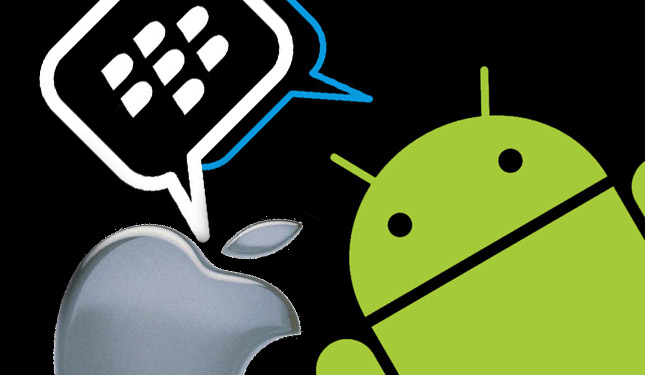Apple’s mobile operating system iOS is one of the most elegant and simple-to-use operating system in the mobile arena. With iOS7, it’s readily apparent Apple has felt the sting of Android–an open ecosystem adulterated by various OEMs like Samsung, HTC, LG, and Sony. To coat the wound, Apple has redesigned the face of their next OS iteration to make it more alike feature wise, against the Android leviathan (which recent IDC reports suggest accounted for 80% of smartphone sales thus far in 2013). Read on for a thoughtful dissection of iOS 7 in terms of BB10–and why BlackBerry’s latest offering is still miles ahead of iOS in terms of user experience, multitasking, and productivity. We’ll also extrapolate why these three are quickly becoming the key tenants for all mobile devices.
Technological convergence. I’ve said it before and I’ll say it again. As all these mobile operating systems mature, we see technological convergence between hardware and software regardless of who builds what. In plainer terms, you’ve got 3-4 different houses all with different layouts, different perks but at the end of the day they are all the same thing, and they all provide the same functions (if not always in the exact same way).

User experience is what truly defines the long term conversion of a user from one OS to another. With carriers making it easier and easier to jump ship, the “experience” is becoming the prevailingabstraction. As users ask “What’s new?” or “What’s different?”, it’s becoming increasingly difficult to put those differences into terms that the new users can grasp without literally holding the various devices in their hands and seeing the often subtle differences and connections between the core applications. Instead, these mobile operating system designers are focused on delivering feature parity lowering the thresholds between competitors offerings and their own.

The conversations have been had before. Do you honestly care what app you’re getting a notification from? Or do you care about the notification itself and being able to react to it in a seamless manner? People don’t give a rats ass whether it’s Bejeweled or Candy Crush Saga that’s *hot* – they want content, whatever it’s called, in whatever way they can get it. It’s a reality that iOS7 seems to acknowledge but not truly understand, and I can only assume the App Store is the cause for this lapse.
In iOS7, you’re still silo-ed off into individual applications when responding to notifications, which on one hand makes sense for common users, but it’s not a giant paradigm shift by any means. Notification Center lets you aggregate all your incoming notifications but you’re still tossed into the respective app to interact with it. While multitasking through those silo-ed apps on iOS is MUCH improved, it hinges on a design concept we’ve seen recycled since 2009 with webOS–and streamlined for buttonless-gestures with the PlayBook OS. It’s “new” but far from fresh in themobile space. You’re still battened down to that silly hardware ”Home” button for moving between apps. This experience, while familiar, is cumbersome for the new age of mobile users looking for a more agile and seamless experience.

iOS7 feels almost no different from previous OS versions, but the added transitions and flashy UI bits like the much over-hyped Parallax effect add to a refreshed, not re-imagined mobile experience. The tedium of moving between app layers on iOS has been overhauled; pulled right out of the BB10 handbook, with a simple left-to-right gesture that you can use to move through app hierarchies. This will be huge for the iPhone users who had to always search around for a digital back button. This also replicates a “full screen” experience that we have on BB10 where most of the UI chrome is at the bottom nearest the thumb, lessening the need for users to bring their hand up to hit a navigation button.
Hitting the home button flies in your app grid which is pleasant to watch, but when moving left and right through your grid there’s not much to see but static off-colored icons that don’t at all seem to match the aesthetic of the new core applications. In BB10, we have a slick fade in and out between app panes that really makes the navigation look smooth. iOS looks rather tacky in comparison–parallax only has a nice pop on some wallpapers. iOS7 hosts your classic bold and bright 3rd party apps standing out harshly against the colorful albeit muted core icons (that have all been flattened and minimized with questionable color options), giving the UI across the OS a very inconsistent feel. Then again, that’s a pain point the general consumer may not care about (and I’m sure devs are well on their way to matching up with the new style).

What’s more is that across iOS7, you’ll see frosted glass through semi-transparent backgrounds in apps; these remind me a lot of Windows Vista from a design perspective, although Apple has added in their own flair of course, adding blur into the transparency mix. Still, there’s nothing earth-shatteringly awesome here. BB10 makes use of semi-transparent grays in a similar fashion. It seems to me that Apple couldn’t decide on a specific direction so they coped out with another legacy design concept that we’ve seen before. It feels like a fresh coat of redundant paint.
One nice thing is that folders in iOS 7 are endless, whereas on BB10 we can currently only hold 16 apps within a folder. Also, folders in BB10 look just like the regular app grid, while in iOS7 they are shown in a zoomed in view where icons are bigger and brighter, this works on many levels, making scanning for the chosen icon much easier. Kudos to them for that.
They both have an “Icon Dock” on the homescreen. While BlackBerry’s is currently uneditable and only has shortcuts for Phone, Search and Camera, you can drag and drop whatever 4 apps you want to the dock on iOS7 (this is no different than their previous offering).
One of my favorite parts of iOS7 is something they borrowed from Android and enabled using a gesture from BB10. A simple swipe up pulls up a kick ass toolbar not unlike what BB10 owners are familiar with on a downward swipe. This toggles in everything you don’t want to have to dig through your settings app to get quick access to. Unfortunately it feels a bit bloated, but it allows you everything from flashlight access to toggling things like Wifi on and off. I personally enjoy that you can control brightness quickly from this screen.

There are further little changes that be found across iOS7′s native apps and I generally like them. They’ve streamlined their UI a lot and across the OS, this feels like a big departure for them. Frankly though, in the hands of someone who has used BlackBerry 10, it doesn’t excite me nearly as much as it will someone already in the Apple camp. The truth of the matter is that they should have launched the iPhone 5 with iOS 7 – now it just seems late out of the gate. BlackBerry 10.2 will drop in close proximity to iOS 7 and will have had many months to mature as a mobile OS. For instance, 10.2 will bring actionable notifications so that we can respond to texts, BBMs, etc without having to leave whatever app we’re in. Jumping back and fourth between apps just to communicate is annoying on iOS. BlackBerry Hub is so much more integral, and our notifications are built right in.

What I really gathered from my time with both OS’ is that iOS multitasking. while vastly improved on iOS7, makes compromises that BlackBerry 10 doesn’t have to. While tasks on iOS are all partitioned or smart scheduled, BB10 has true multitasking built-in from the core. The way apps run on the two OS’ is very different. iOS has to compensate for the multitude of applications by pulling in app data in the background. This tossing back and fourth between active and background states used to kill battery and performance (especially on older devices with lower specs), however with some smart innovations (ones they used within Mavericks) they’re able to make the multitasking much more transparent. Then again, it’s still just slick task switching. Developers must build into these APIs to get the full benefit of the system.

On BlackBerry 10, multitasking is done at the kernel level with each application running in real time in memory protected space. In the multitasking center of BlackBerry 10, you can run up to 8 applications simultaneously. If an app crashes or hiccups, it’s dropped from memory protected space and the rest of the OS runs as if nothing happened — one fault doesn’t cripple the entire system, a pain point for most other OS’ aside from BlackBerry’s. (Not to mention the headless app support coming in 10.2). BlackBerry’s software is used in dangerous medical equipment that can’t glitch or lag or break. The QNX Medical RTOS actually has the ability to restart itself without having to close running processes. This results in 100% uptime (Wrap your head around that). Apple has done a great job slapping a lot of usability onto their next OS, but as a core system it’s no better than it was when it launched in 2007. They have done a lot of upkeep, tightening the integration of some core apps, but there’s nothing here that BB10 can’t already do when it comes to multitasking. The invocation framework in BlackBerry 1o is top notch.

From an efficiency standpoint, there is no beating BlackBerry 10. UI concepts like ‘Peek.’ allowing you a simple swipe to move through app panes, check notification and even begin entry into your unified inbox BB ‘Hub,’ moving between apps seamlessly through ‘Flow’… it really does create a nice trinity of communication bliss. iOS masks its shortcomings very well in this sense, but everything is very disparate. What I have found is that iOS7 is a great consumer UI but BlackBerry 10 is very utilitarian, focusing on what’s going to make your time with your phone as agile and efficient as possible. From the flick keyboard to the timeshift camera, your time is valuable and BlackBerry 10 is easily the most proficient mobile OS that’s ever been built, and it’s got intelligence and charm without the gimmicks of iOS. For me, it comes down to DNA and the markets to which these two OS’ cater. I think they are talking to drastically different user bases and, as such, have different solutions for those bases.
There are ideas in use on BlackBerry 10 that are leagues ahead innovation-wise. While iOS7 feels like another chapter in a slowing story, dressed to impress but somehow out of touch with the rate that it will be leapfrogged in the coming years. Apple needs to seriously assess its platform as we begin to move into deeper connections between our phones and other smart devices. User experience is so much more than what you see, but how you end up having to interact with it. UX is leagues ahead on BB10 vs iOS7.











 1 1 Not a bootrom error: The OS is resetting During init!
1 1 Not a bootrom error: The OS is resetting During init!












